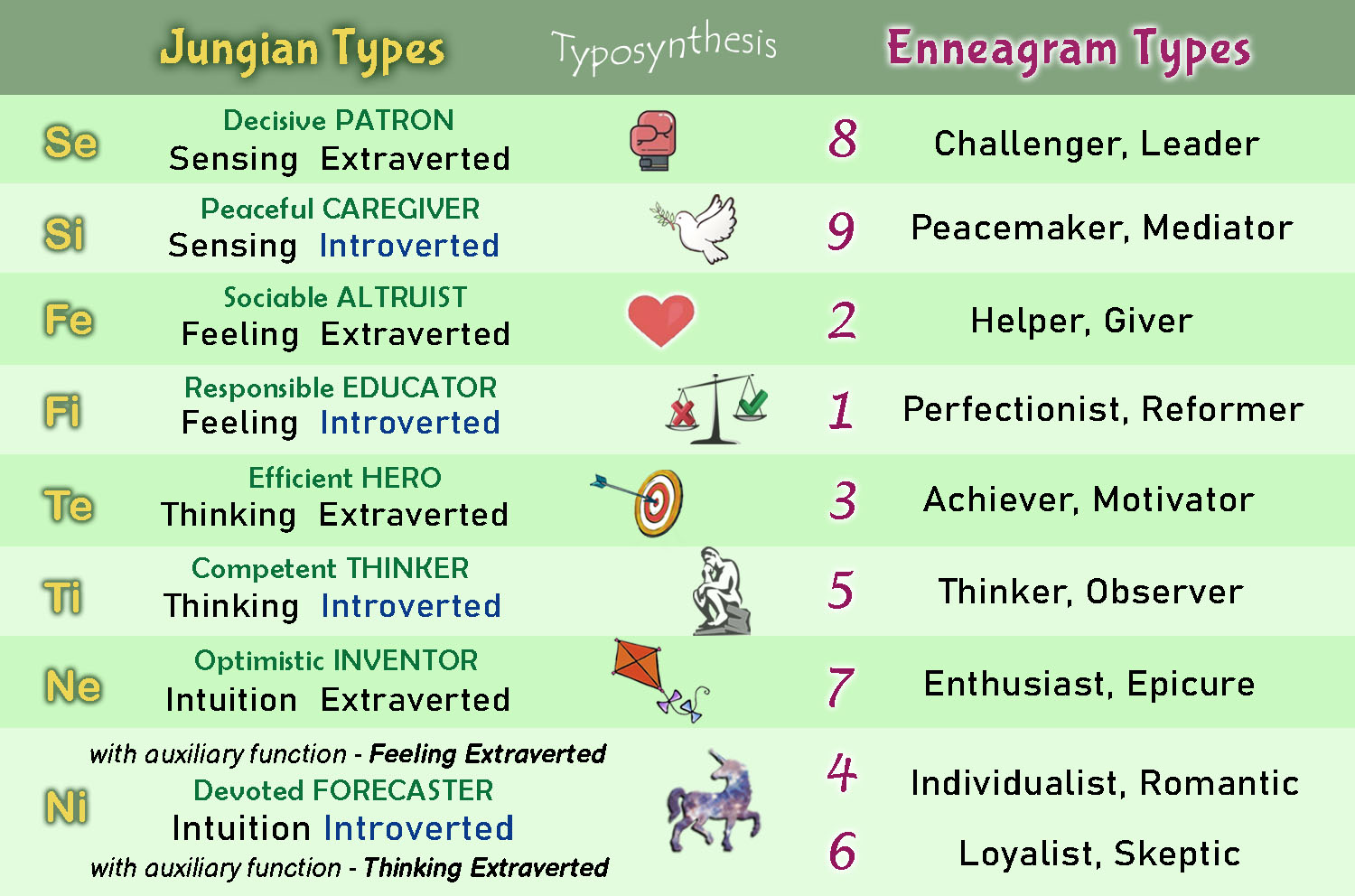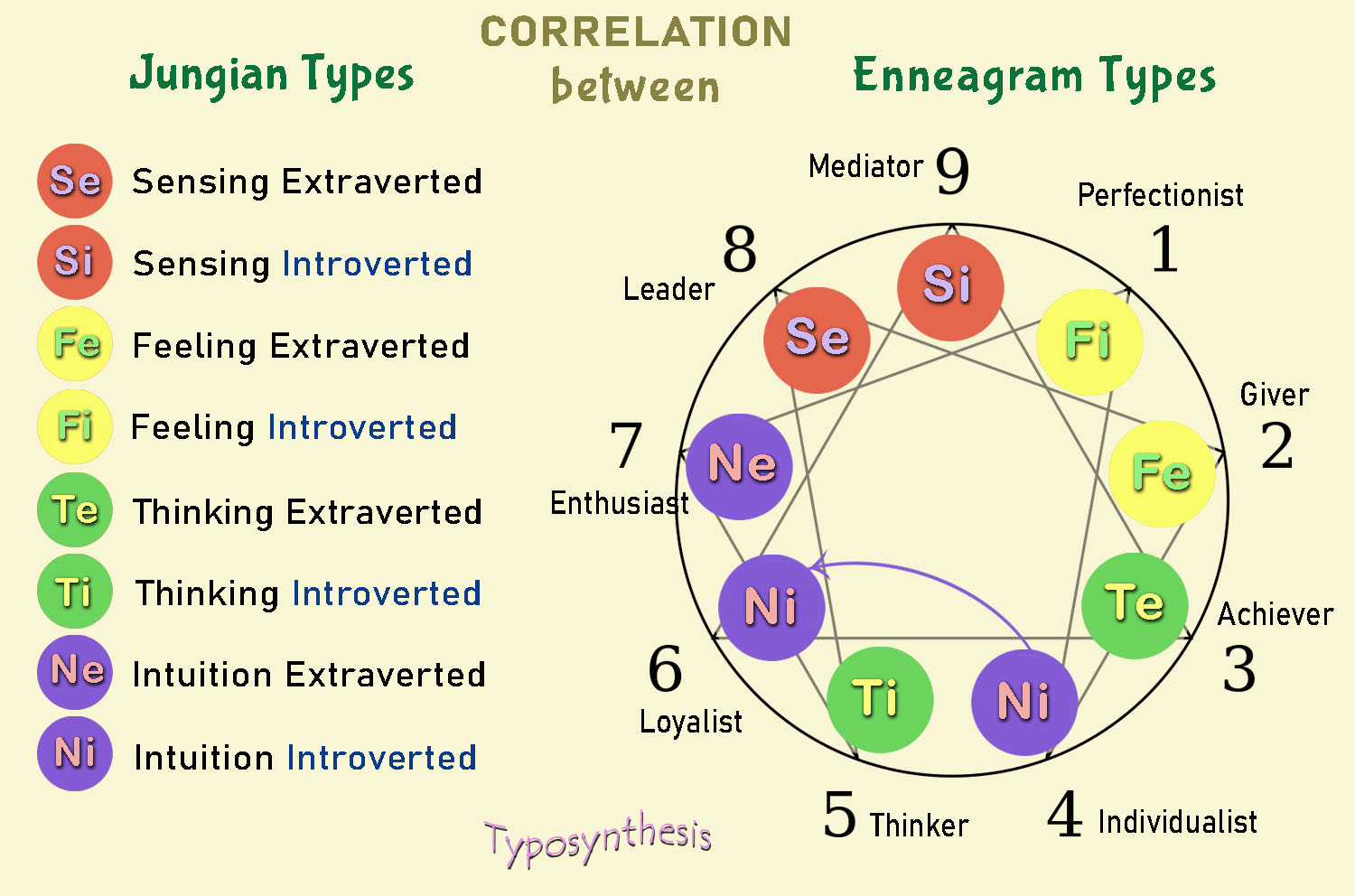Correlation between Enneagram and Jungian Typology
While studying the Enneagram and Jungian typology, I came to the conclusion that these two typology systems describe the same personality types using different parameters for description.
I want to note that I am writing about Jung's typology, which has 8 types, and not about the MBTI. MBTI is just a small slice of Jungian typology. Jung's typology, in contrast to the MBTI, talks about the nature of neurosis of each type and about the levels of psychological maturity of the types.
Unfortunately, not many people can compare the 9 Enneatypes with the 8 Jungian types, since Jung's 1921 book “Psychological Types” is written in very complex language and there are no modern descriptions of types written in plain understandable language.
I have compiled simple modern descriptions of Jung’s 8 types, which make it easy to assess whether these two typologies are correlated and how they complement each other.
*Decisive PATRON
*Peaceful CAREGIVER
*Sociable ALTRUIST
*Responsible EDUCATOR
*Efficient HERO
*Competent THINKER
*Optimistic INVENTOR
*Devoted FORECASTER
Full descriptions here >>>
Claudio Naranjo ("Character and Neurosis") and Don Richard Riso (“Personality Types Using The Enneagram for self-descovery”) compare Enneagram and Jungian typology. Their correlation is in the table below.
|
Enneatypes |
Don Riso |
Claudio Naranjo |
|
|
|
Jung |
Jung |
MBTI |
|
1 |
Te |
Te |
ESTJ |
|
2 |
Fe |
Fe |
|
|
3 |
|
|
ISTP |
|
4 |
Ni |
|
INFJ, INFP |
|
5 |
Ti |
Si |
INTP |
|
6 |
Fi |
Ti |
ENTJ |
|
7 |
Se |
Ne |
INTJ |
|
8 |
Ne |
Se |
|
|
9 |
Si |
Fi |
ISTJ, ESFJ |
* * * * *
In general, for each of the 8 types, the following gradations of human psychological harmony can be distinguished (from total harmony to strong disharmony, from purity to pollution):
* PUEST MANIFESTATION OF FUNCTION - manifestation of one of the 8 main archetypes integrally and without distortions due to the process of individuation.
* SOCIAL ROLE - a person's strengths resonate with the corresponding demand from society.
* NEUROTIC ROLE - a person wants to be useful to society with its strengths, and in return expects support for one’s self-esteem.
* MANIPULATION - Through manipulation, a person tries to shake out desirable behavior from people in order to support one’s self-esteem.
* AGGRESSIVE IMPOSITION - forcibly dragging others into one's destructive scenario.
* SELF-DESTRUCTIVE DISAPPOINTMENT - the loss of hope that someone will support his or her self-esteem. Disappearance of any goals and motivations.
If we compare the social role of a type from one typology (Enneagram) with the manipulation of the same type from another typology (Jungian typology), it will seem to us that we are facing completely different types. Thus, before comparing types from different typologies, we must first understand how, within the same typology, the characteristics of the same type change depending on the degree of psychological harmony or disharmony of the person.
In this article, I have figured out (analyzed) the behavior of two Jungian types (Se type and Ni type) on three levels of psychological harmony-disharmony: social role, neurotic role and manipulation. I hope this will help readers gain a better understanding of Jungian types and try to compare two typologies themselves: the Enneagram and the Jungian typology.
Claudio Naranjo, in his book “Character and Neurosis”, has well described the levels of manipulation, aggressive imposition and self-destructive disappointment, and Don Riso, in his book “The Wisdom of the Enneagram”, has well described the levels of social and neurotic roles. As for Jungian typology, in his book "Psychological Types", Dr. Jung places the greatest emphasis on the disharmonious manifestations of types.
In his work "Character and Neurosis", Claudio Naranjo compares the Enneagram of personality types with other psychological character typing systems and discusses of the origins of each type.
After analyzing the characteristics of each of the Enneagram and Jungian types, as well as using the relation between Enneagram types and DSM*, established by Claudio Naranjo, I made the following correlation between these typologies:


* DSM or Diagnostic and Statistical Manual of Mental Disorders (latest edition: DSM-5-TR, published in March 2022) is a publication by the American Psychiatric Association (APA).
Anzhelika Zabava
* * *
MBTI & Enneagram Correlations by Dr. A.J. Drenth here >>>
Last updating: 14.06.20022
